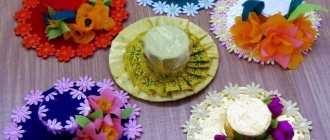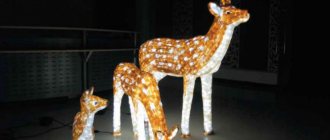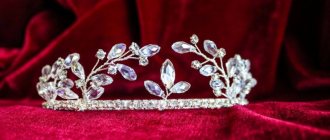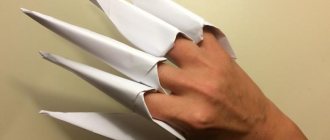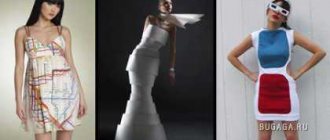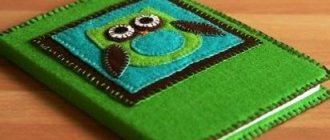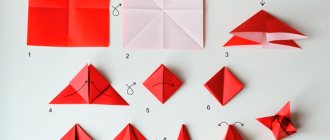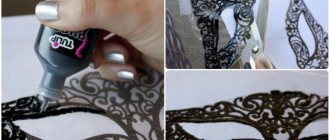A night light is simply irreplaceable in a room where a small child lives. The baby will not be afraid of the dark if a night light glows softly by his bed. Adults love night lights too. They give the room coziness. You can find a wide variety of night lights in stores. But a hand-made lamp will definitely be exclusive and the most interesting.
Paper night light
A paper night light is made using an awl and thick cardboard. How to make a night light with your own hands? To begin with, the cardboard needs to be laid out on the table. It is better to place a cutting board or something similar under it. A drawing is applied to the sheet, and then holes are pierced along the drawn lines.
The resulting perforated material is rolled into a cylinder. Inside you can place a socket with a light bulb, an LED strip or a Christmas tree garland. Light will penetrate through the holes and paint light patterns on the walls of the room.
Making an LED night light with your own hands is not only pleasant, but also useful!
There are countless ideas on how to make an LED night light with your own hands, which naturally depends on your imagination, needs and design. For example, in the evening, when it is completely dark outside and you don’t want to get up yet, you can read a book right in bed. Some night owls use a table lamp for this, but what if it doesn’t match the interior of the room? Or another case when a child is afraid to fall asleep in a dark room.
Contents of the article on how to make an LED night light with your own hands
- LED night light from an old electrical plug
- Scheme of a night light from a faulty fumigator
- Night light for children's room
- Assembling a night light from a charger for a mobile phone
- DIY miniature LED night light
- Unusual idea for the bedroom
- Creative options for LED night lights
- Video about making a DIY LED night light
- conclusions
We will look at several options for LED night lights that you can make with your own hands and use them to decorate a child’s room, your bedroom or a coffee table near an armchair, and also get muted and pleasant energy-saving lighting from them.
LED night light from an old electrical plug
To make the simplest LED night light using an electric plug you will need:
- electrical plug;
- Light-emitting diode;
- capacitor 0.4 µF x 400V;
- electrolytic capacitor 47 uF x 20V;
- Zener diode KS133A;
- resistor 100 Ohm, 0.125 W;
- resistor 200 Ohm, 0.125 W;
- 4 diodes
- PVC pipes.
First, disassemble the electrical plug and remove the protective ground pin and the clamp that is used to clamp the electrical cord. Then grind off the rim of the LED using a file. PFC tubes are necessary to prevent short circuits. In accordance with the presented diagram, the elements are assembled, then they are placed in an electrical plug.
Naturally, you can buy an LED lamp; now manufacturers are producing interesting inexpensive options. What LED lamps are there and what you need to know when choosing them, read another article.
Scheme of a night light from a faulty fumigator
Scheme of a night light from a faulty fumigator
To make this night light, you will need:
- faulty fumigator (mosquito repellent)
- 2 ultra-bright white LEDs;
- 2 capacitors;
- diodes;
- resistor.
Using the fumigator body, LEDs are installed in place of the faulty heating element. Voltage from the electrical network is supplied through capacitor C1; the reactance of this capacitor drops excess voltage to the rectifier bridge VD1-VD4 on the available KD209 diodes. At the bridge output, a load resistor R2 is included, as well as a capacitor C2 to smooth out the ripple. Constant voltage from the capacitor is supplied to white ultra-bright LEDs HL1 and HL2.
Keep in mind that the voltage of capacitor C1 should be from 400V. This also applies to replacing the rectifier bridge diodes. Set the number of LEDs as needed. This does not fundamentally change the connection diagram.
Night light for children's room
In such a night light you can use a low-power incandescent lamp. But... If you are wondering how much electricity such an ordinary lamp will “draw” in a year, then we will calculate it! For example, if you take a lamp with a power of 25 W (quite enough!) and multiply it by 6 hours of operation, and then multiply it again by 364 days, you get only 54 kW. On the one hand (in terms of money) this is a small amount. However, you can save money by buying an LED night light, or you can make it yourself. The power of LED lamps is much less than conventional ones, and the lighting is no worse. Therefore, an LED night light will be an excellent option for decorating a room.
Don't think that you will need a lot of parts and tools to assemble it! Just an old charger, LEDs (the number is up to you) and resistors. Buy the brightest LEDs. It’s even fashionable to buy multi-colored ones. The proposed assembly circuit is suitable for both wide- and narrow-beam LEDs. If you consider narrowly directional diodes, it becomes clear that the light falls in one direction. It is best to connect such a night light to the main lighting, for example, a chandelier on the ceiling (with a double switch!) Instead of a housing, you can use the housing from the selected mobile charger, which should accommodate all the parts of the lamp. The task is not entirely simple, but it is quite doable!
Assembling a night light from a charger for a mobile phone
LED night light circuit from a charger
First you need to know the mobile charging power. Let's say it is 6 volts. Now, if you don’t remember Ohm’s law from school, then “drive” it into a search engine and use it to calculate the resistance of resistors (current-limiting ones). This is necessary for the correct selection of resistors, because all LEDs have different voltages. And do not forget to make sure that a current not exceeding 20 mA passes through the LED. If the voltage of a group of diodes is the same, then they can be connected to one resistor. Of course, the light may be a little uneven, but this is almost invisible to the eye. After finishing the assembly, glue everything together with super glue and secure it in the center of the ceiling near the chandelier. During the daytime, this lighting device is practically invisible, and at night it will save the child from the fear of darkness and loneliness. And further! The power of the night light is only 7 W. Impressive? To learn more about saving electricity when using LEDs, read the article power ratio of LED lamps.
Now let's talk about assembling a night light from a charger for a cell phone in more detail.
There are two types of night light:
- switched on from a stationary switch (stationary);
- plugged into an outlet (portable).
Assembly technology for a stationary LED night light
To assemble an LED night light with your own hands we will need:
- unnecessary phone charging;
- a pair of resistors;
- 4 bright LEDs.
Personally, I used white, blue, green and red LEDs. The first three types are FYL-8013UWC. The maximum current consumption is 20 milliamps. The voltage at which the current required to produce light flows through the LED is in the range of 2.8-3.6 Volts. The red LED I have is FYL-8013URC. The voltage to produce the glow is less here - 1.8-2.3 V. Although it is better, of course, to use LEDs of the same power. All LEDs are of the narrow-beam type - with a glow angle of no more than 15 degrees. Such diodes are usually used in LED flashlights. Now I will tell you about the assembly and installation of my night light.
Since I was using highly directional LEDs, I decided to mount them on the ceiling in the center of the room, next to the chandelier. Thus, each LED will shine in one of the four corners of the room, providing uniform illumination of the room with light of an interesting color scheme. The current in the LED night light will come from the second, unused group of chandelier wires. That is, the night light will be turned on by the same switch as the chandelier. To do this, you must have a two-key switch - one key will turn on the chandelier, the second will turn on the night light. I personally really like this approach due to its ergonomics and - you don’t need to install a separate switch for the night light - drill a hole in the wall, take out wires, etc.
LED night light assembly
The body of our night light will be the plastic case of an old phone charger. First, let's measure the voltage at the output of the charger. For me this figure was 6 V. Now it is necessary to calculate the resistance of the current-limiting resistors. We will do this using the good old Ohm's law, which states: Current strength is directly proportional to voltage and inversely proportional to resistance. I will not delve too deeply into the theory, but will only present my calculations. I will only say one thing: each LED requires a separate resistor, which will ensure a uniform supply of current to the LED - 20 milliamps. For example, my white LED has a drop voltage of 2.8 V. Thus, we will select the resistor using the following formula:
R= (Usupply – Udrop)/Iconsumption= (6-2.8)/0.02= 160 Ohm.
Three of my LEDs - white, blue and green - have the same voltage drop - 2.8 volts. This means they can be combined into one group. The only disadvantage of this method is that the glow of the LEDs will be non-uniform, although in practice this is almost imperceptible. By combining 3 diodes into one group, I only used 2 resistors instead of four - one for the group and one for the low power red LED.
Once the LEDs are grouped, calculate the required resistor value for a group of three diodes. The resistance of the resistor is equal to the supply voltage divided by the current drawn by the LED. The minimum voltage drop across my diodes is 2.8 V. If we subtract 2.8 from 6 Volts (the voltage at the charger output) we get 3.2. Current consumption is 60 milliamps (3 diodes of 20 mA each) or 0.06 Ampere. Thus, the required resistance will be:
R=3.2/0.06=53 Ohm
There is no 53 Ohm resistor - I took the closest one at 56 Ohms. Before connecting the resistor, it is necessary to calculate its required power so that the resistor does not burn out. This can be done using the following formula:
P(power)=UxI
Substituting the values, I got: P=3.2x0.06=0.192 W. Thus, the resistor power must be at least 0.25 W.
And now, homework: I suggest you independently calculate the resistor values for the red LED using the above formulas. J Please indicate your answers or questions in the comments below.
After the LEDs are connected, we assemble the body of the night light, attach it to the ceiling using glue or other materials, connect it to the electrical network and enjoy operation.
Assembly technology for a portable LED night light
Once you have studied the technology for assembling a stationary LED night light, it will be much easier for you to assemble a portable one. Here it is best to use a 1 Watt white LED. The current supplied to the LED will be 75 milliamps. The output current here will depend on the capacitance of the film capacitor; the operating voltage of the capacitor should be in the range of 250-630 Volts. With a capacitance of 1 microfarad at the output we obtain a current of 75 milliamps.
To prevent voltage surges from burning out the LED, it is necessary to install a current-limiting resistor. You can select the desired resistor using the formulas that I indicated above. We also need a diode rectifier to convert alternating current into pulsating current. As a body for our lamp, you can use the body of an old night light or, for example, a mosquito fumigator.
DIY miniature LED night light
/wp-content/uploads/2013/09/Nightlight-with-your-hands-in-5-minutes.mp4
To make a small night lighting in a room, it is not necessary to buy a ready-made and not very expensive lamp. To illuminate a room, it is enough to make a night light yourself, consisting of several LEDs. Buy a matrix of red LEDs, which will not only light up the room a little, but also create a cozy and intimate atmosphere. You will also need an old charger, a semiconductor diode and a fixed resistor. To assemble it you will also need a plastic plate for the front panel, glue and a small screw. From the tools, prepare a soldering iron, a square screwdriver, a knife and pliers.
Pre-cut the front panel from the prepared material to the size of the LED matrix. Then you need to solder an electrical circuit consisting of an LED, a resistor, a rectifier (diode) and a charging plug. All exposed soldered metal joints should be insulated with heat shrink. The front panel must be glued into the body. Everything is simple and fast. The night light is ready for use!
Unusual idea for the bedroom
/wp-content/uploads/2013/09/IDEA FOR A NIGHT LIGHT OR A CHANDELIER WITH YOUR OWN HANDS.mp4
Who hasn't wanted to create decor with their own hands and feel like a professional designer? If you like to read a book while lying in bed before going to bed, then this option is for you, unless, of course, you purchased a huge Chinese fan in advance! With its help you can create local lighting at the head of the bed. In a word, you will make an LED night light with your own hands and update your interior. In addition to the fan, you will need an LED strip, which must be fixed to its bamboo edges.
There is another idea for the home, and it is a night light that is tied into a rug. This mat-night light is placed near the bed and if you need to go to the kitchen in the middle of the night, its light will not wake up your “other half”. An LED strip, which is tied with a hook with a rope of the color and texture that suits you, is suitable as a lighting device for this idea.
Instructions for assembling LED products
Creative options for LED night lights
Night light starry sky"
There are several interesting options for LED night lights:
| No. | Name of idea | Short description |
| 1. | "Starry Sky" | A very beautiful option, especially for a children's room. You can use an awl to make holes in a tin can in many places, and place an LED night light inside. Then paint the jar matte blue and decorate with sparkles. Turning on such a night light in the evening, the room will be filled with a magical starry glow, which will greatly delight your child. |
| 2. | "Fairytale house" | Great LED night light idea. Take a piece of cardboard and draw on it a diagram of a house with windows, doors, and stained glass windows. Paint it with paints and decorate it to your liking. Place a night light inside the lamp. When everything is ready, show the product to your loved ones. They will be delighted both by the beauty that appears before their eyes and by your talent. |
| 3. | Lamp from a can | Take an ordinary tin can, cut an oval hole in it, and insert a cardboard grid into it. Decorate the outside of the jar to your taste, and place an LED lamp inside - you will get an incredibly interesting figurine that will at the same time bring practical benefit - to illuminate your room at night. |
Night light “Fairytale House”
Video about making a DIY LED night light
conclusions
Of course, if you are not a radio amateur or an electrician, it’s easier not to bother with all this and buy a ready-made night light. But if you are reading this article, it means that you are seriously thinking about assembling an LED night light with your own hands. Well, this is not only good practice for you as a radio amateur, but also a very profitable venture. Today, Chinese night lights cost up to $5 apiece, and this, however, does not in any way guarantee that such a device will last you more than a year. Therefore, if you have time, try to make an LED night light with your own hands, and I will be happy to help you in this endeavor by answering questions in the comments to this article.
- What repair tools are useful to have at home?
- 5 reasons to carry out repairs only by professionals
- How to soundproof a wall
- How to make a rock garden
Night light starry sky"
Using a similar technique, you can make a night light that projects stars and the moon onto the ceiling of the wall. For this you will need:
- Glass jar;
- Awl;
- Foil;
- Cutting board;
- Lid;
- Scotch;
- Flashlight or garland.
The pattern of stars and constellations should be drawn on folded food foil and, placing it on the board, pierce holes with an awl, as in the previous instructions.
Place the finished foil with the pattern inside the jar along its walls, secure with tape.
Place a light source in the jar and cover with a lid; if the night light is to be plugged into the network, first make a hole in the lid for the wire.
Turn the jar upside down and enjoy the starry sky. Children and teenagers will especially like this night light.
Projector starry sky
This version is usually used most often because it is neutral and children like it. Various ideas and instructions on how to make a night light offer many ways to create this craft, and we will look at a few simple options. It will not require large financial and time expenditures.
You need to find a suitable jar and a battery-based flashlight. Although you will have to rely on an extensive set of additional materials:
- The jar must be made of glass and have a lid. We recommend looking for the cylindrical version as it is easier to work with;
- You will need a large sheet of hard foil to cover the entire area of the jar;
- Actually a working flashlight with batteries;
- Scissors with a convenient size;
- An awl to complete the creation of the night light.
It is necessary to cut a sheet of foil to place inside the jar. Holes are created on its entire surface using an awl. Now the included flashlight is sent to the jar and the starry sky is actually ready for night viewing. But, if this does not seem enough, you can cut out the outlines of Ursa Major and Ursa Minor on foil, since children love to look at these constellations. To do this, you need to check the real location of the stars and transfer it to the craft.
A night light in this style can be made in another way. A large tin can will do. It is necessary to remove the wrapper and perforate it with an awl in the right places to form constellations or stars that fill the night sky.
You can put a flashlight or candle inside. The last option will add a dose of romanticism.
LED night light
It is very easy to make a night light with your own hands from LEDs. Since LEDs do not heat up, they can be combined with any materials. You can cut out any figure from cardboard or wood, attach it to the wall and place an LED strip behind it. The figure will be beautifully illuminated and illuminate the room. The more ribbon you attach, the brighter the night light will be.
If you attach a strip with diodes to a battery, you get a portable night light. LEDs can be placed in a base made of plastic or rubber (an old toy, for example). Craftswomen can make a lampshade for a night light from papier-mâché, yarn or starched fabric.
Kinds
May be interesting Do-it-yourself tool box: material, manufacturing instructions, photos Dates for the start of collecting birch sap in the Moscow region in 2021 The influence of wind on the soil
Night lights are distinguished by type of design. You can make such an interior item in any shape and design. The main thing is to provide a stand or attachment to the head of the bed. An unstable product may fall, which means the lamp inside is likely to break. To avoid such incidents, products made from durable materials, such as plastic or wood, are often used for children's rooms. In this case, the lamp can be replaced with an LED strip: it is less susceptible to mechanical damage.
The most common type of night light is tabletop. It can be placed on the nightstand next to the bed. Floor lamps are used less frequently. They take up more space and are not always combined with the interiors of a children's bedroom. The switch for both types of night lights is located on the wire, so you can reach it without getting out of bed. Manufacturers of table lamps sometimes make the button directly on the body, but this option is less practical.
There are also night lights:
- Wall or sconces. It cannot be accidentally knocked down, because... It is attached at shoulder level. You can turn on such lighting by pulling a rope or chain attached to the main body.
- Hanging. They are similar in design to sconces, but take up more space. Suitable for rooms decorated in a modern style. Several of these lamps can be combined so that they are turned on with one button.
- With motion sensor. A night light with this function does not have to be turned on yourself. They are often used in large rooms where you need to walk a considerable distance from the chandelier switch to the night light.
Attention!
You can make a night light at home from scrap materials of any type. For some designs, for example with a motion sensor, you will have to purchase special electronics.
Night light "cloud"
If you are wondering how to make an unusual night light with your own hands, make a glowing cloud. To do this you need to prepare:
- Wire frame;
- Thin white fabric;
- Medical cotton wool;
- LED strip;
- Threads;
- Glue.
A simple lampshade is made from a round or oval wire frame and fabric. LEDs are placed inside the lampshade. A thread is attached to the upper part of the lampshade, with which the night light will be attached to the ceiling.
Instead of a thread, you can take a fishing line, then it will not be visible at all and the cloud will float in the air. Large pieces of cotton wool are attached to the lampshade fabric with glue. It is better to first fluff the cotton wool with your hands so that the cloud is voluminous and looks like the real thing.
Night light made from clothespins
Children can be involved in the process. They will use this thing with pleasure. To realize the idea, wooden clothespins are needed. Approximate quantity is about 100 pieces (depending on size). The metal spring is removed from them. The two halves are glued back together with wood glue, but without the mechanism. The prepared clothespins are glued on top of each other to the selected height. The number of these blanks depends on the shape of the lamp:
- For a square - four pieces.
- For a hexagon - six.
- For a triangle - three.
A piece of board or timber is used as a base. They are first sanded and a hole for the wire is drilled. The parts are glued to the base. Install the cartridge, wire, plug. Screw in the LED light bulb. It is possible to place an LED strip. The finished night light is painted or coated with varnish or stain. It looks very original, and production costs are minimal.
There is an option to add a lampshade to the craft. It is made from scraps of fabric. For bright light, thin fabric (tulle, silk) is suitable. For a more subdued look - thick (cotton, knitwear). For a double effect, the canvas is made up of shreds of different thicknesses.
Using imagination and available materials, you can create an unusual night lamp. Children will love it and will help them overcome their fears. It is important to follow the assembly rules to ensure safe use.
Garland night light
If you didn't put away your New Year's decorations in time, feel free to use them to create a night light. In addition to the garland, you will need a glass jar. Just place the garland, folded in a chaotic manner, in the tank and turn it over. If you stick phosphorescent stickers in the form of stars or crescents on the jar, this design will please the eye even after it is turned off.
Be careful, some garlands can get hot, watch the temperature of the glass jar. If it gets very warm, it's time to turn off your homemade night light.
If you have scraps of New Year's tinsel left at home, you can put that in a jar and then the lights will shimmer in different colors.
Making a night light from a tin can
The easiest and fastest way to make a projector with a “starry sky” effect is to use a lamp from an ordinary tin can. It is worth noting here that absolutely any cans can be used as the basis of a lighting fixture. It is only advisable to give preference to those banks that are of sufficient size. A small tin can won't do much good. It is better to use a container from condensed milk or canned fruit.
Note! The choice of the size of the tin can should be made according to the dimensions of the room. In a small room, the “starry sky” can be realized with a small lamp, but for a large room you can use one large jar or several small ones.
It is also worth noting that to do it yourself you will need a small set of materials and tools. The list of required items includes:
- tin;
- an awl or nail (even a bent one will do);
- paint of any color, but it is advisable to give preference to darker shades: blue, purple, black. This way you can create a suitable lamp in appearance and surroundings;
- autonomous light source. It can be a regular candle, a portable flashlight, or a stand-alone light bulb.
The process of making such a night light looks like this:
- Wash the selected tin well. It must not only be washed, but also cleared of the label. This is very important to do, especially if you plan to use a candle as a light source. An open flame can burn the label and cause a fire;
- Using a nail or an awl, we make through holes in the jar on its side edges and on top;
Note! The holes can be made randomly, or you can use a star map to create familiar outlines of the constellations. In the latter case, you can simply apply a design to the jar and make holes through it.
Making holes
- paint the jar in the chosen color;
- We put a candle or any other light source and cover it with our finished jar on top. That's it, the lamp is ready.
Ready night light
As you can see, you can make such a lamp with your own hands very quickly, spending about half an hour on it.
Night light "infinity"
Night lights with an infinity effect began to be found in stores. You can make a similar lamp with your own hands. To do this, prepare:
- Wooden plank for the base;
- A strip of aluminum or foil;
- LED strip;
- Translucent glass;
- Artificial acrylic mirror.
Next, do the following:
- Make grooves in the board for acrylic and glass panels;
- Place foil between the slits in the form of a rectangular outline;
- Using glue and wire, secure the LEDs along the foil strip;
- Insert acrylic and glass into the grooves;
After turning on the LEDs, the light from them will be reflected from the metal and mirror, creating an endless corridor of lights.
Night light from charger
Many people buy a low-power incandescent lamp for their children's room. But such a device will be relatively expensive. Therefore, here you can make do with household items you don’t need, such as an old mobile phone charger. This is one of the most common ways to make your own LED night light. The list of required materials here only includes an old charger, a resistor and LEDs.
Note! You need to buy the brightest LEDs in terms of light characteristics. You can also use multi-colored LEDs.
That’s why this option for making a homemade night lighting device is so popular. The lamp assembly diagram looks like this:
- find out the power of the charger;
- Using Ohm's law, we calculate the required resistance for resistors (current limiting). Please note that if the calculations are carried out incorrectly, the resistors will also be selected incorrectly, and this can lead to burnout of the components of the electrical circuit. In addition, these calculations will help you choose LEDs, since they all have different voltages;
Note! A current that exceeds 20 mA should not pass through the diodes.
- open the old charger;
- We install new components into its body according to the diagram below.
Scheme
Note! This circuit is suitable for narrow and broad-directional diodes.
Finished device
- If the voltage of the diodes matches, it is possible to connect them together to one resistor. In this situation, the light may turn out to be inhomogeneous, but such a defect will not be very noticeable;
- solder the electrical circuit;
- we insulate all soldered joints with heat shrink;
- glue the front panel into the body;
- then glue everything together with superglue;
- install the night light in the required place. It is better to install it on the ceiling.
It is recommended to connect the resulting lamp to the main lighting. For example, a chandelier with a double switch is perfect in this case. As a result, you will receive a lighting device whose power will not exceed 7 W. At the same time, doing it following the scheme described above will not be very problematic. As you can see, a wide variety of electrical appliances that are already out of order or simply not needed can be used as the body of a lighting fixture. This is precisely what determines the advantage of making night lights using LEDs. For large devices, whole pieces of LED strip can be used. It all depends on what you ultimately need. Remember that the key to success here is a properly soldered electrical circuit. And our article will help you with this.
Night light "moon"
Before starting work, lay out on the table:
- Round balloon;
- Acrylic paint white or beige;
- Paper towels;
- PVA glue;
- A sponge with large pores.
The “moon” night light is made like this:
- Draw a circle with a diameter of 7 cm around the tail of the inflated balloon;
- Apply glue to the ball or dip it in a container of PVA;
- Place paper towels on top;
- Repeat steps 2 and 3 three times;
- After the last layer of paper has completely dried, paint the surface with white paint;
- Dip a sponge into the paint and apply it to the ball in several places (the previous layer of paint should be dry);
- Cut a circle around the tail of the ball;
- Carefully pierce the ball and remove it from the “moon”;
- Insert a safe light source inside the night light.
Night light made of wood
Night lights made of natural wood look very modern and at the same time cozy. You can create such a night light with your own hands, including. In order to make a wooden night light with your own hands, you will need:
- Wood cutting;
- Drill;
- Saw;
- Jigsaw;
- Hammer;
- Chisel;
- Sandpaper;
- Light source;
- Luminescent paint.
- You need to cut a cylinder inside the cut of the tree. You should end up with a hollow cylinder without a bottom or a lid. To do this, you will have to use a drill (to make through holes) and a jigsaw to cut the core. If it doesn't budge, use a hammer or sledgehammer.
- The finished stump without a core needs to be removed from the bark.
- Work the inside with a rounded chisel to make it even;
- Give the desired shape to the top of the future night light.
- Sand all surfaces of the stump.
- Transfer the design you like onto the surface of the wood.
- Use an electric jigsaw to cut out holes or an entire design.
- Inside the stump, place a lamp or LEDs on the bottom of the night light.
- Cover the wood with varnish or stain.
- Cover the inside surface of the night light with luminescent paint.
The lamp located below will give a soft, diffused light, and after turning off, a glow from the special paint will emanate from inside the stump.
Depending on the materials you have at home, you can make many different night lights. Be sure to try your hand at creating one of them, and your imagination and creativity will help you make an exclusive piece of furniture.
https://youtu.be/DUYaOZLc_Vwhttps://youtu.be/-pW3KX6sWtg
_
Varieties of homemade night lights
Below we will consider the most common options for making night lamps with your own hands.
Night light made of transistors in the shape of the moon
To build a lamp you will need an LED strip and two transistors through which the first element is connected. The first transistor will automatically regulate the device due to the incident light, after which it will trigger the second transistor, which directly turns on/off the flexible board.
By adding a resistor to the circuit, you can adjust the sensitivity and threshold at which the transistors operate and the backlight lights up.
As for the design of the night light, before starting work, find a sheet of plywood and cut a circle out of it. The base should resemble the letter "O". Use a printer and print out an image of the Moon. When everything is done, take a drill in your hands and drill two holes. One - in the upper part, will serve as a fastening of the night light to the wall, the other, in the lower part - will be used for pulling the cable.
Next, glue the base of the lamp to the circle of plywood using special PVA wood glue. You will first have to sand the surfaces, making them perfectly flat and smooth. Be sure to degrease, otherwise adhesion will be weak. The design as a whole is as simple and understandable as possible.
After a few hours (until it dries completely), measure a piece of LED strip, placing the board along the edge of the letter “O”. Cut off the excess portion at the location indicated by the manufacturers (look for the picture of “scissors”).
Then proceed in the following order:
- Solder the wires and LED strip.
- Glue the printed image of the Moon onto a circle of plywood. Take your time and smooth out any wrinkles. The edges need to be folded, forming a “skirt”, which will have to be cut off later.
- Wait for the glue to dry.
- Drill a hole to install the photocell. Choose a place so that the element matches the glued image.
- Remove the protective layer located on the back of the flexible board, and then stick the LED strip around the perimeter of the oval. Pass the wire through the pre-made hole in the bottom (read above).
- This hole must be used to pass the power cable coming from the source (distribution panel, outlet, etc.).
- Use a regular nylon tie to tie the wires together.
- The transistor connection diagram can be found on the Internet - it is as simple as possible. Unfortunately, you can’t do without the basics of electrical engineering here.
- Solder the wires to the photocell and use heat shrink tubing to improve the insulation.
- Solder the wires from the power cable to the working board.
- It is recommended to attach the board to the lamp using Velcro or other quick-release elements.
- Place the photo sensor in the pre-made hole and secure it with glue.
Hang the finished device in the room where you plan to use it and enjoy the result. Using a switching power supply, you will protect yourself and avoid unnecessary expenses: when the night light is turned off, but the power supply is plugged in, the latter will consume virtually no electricity.
LED night light from an old electrical plug
Another simple night light that you can make with your own hands is made from a regular electrical plug. Of course, unlike the “porridge from an axe”, you won’t be able to create a lamp from one plug, so you will need LEDs, two resistor elements, two capacitors, a zener diode and polyvinyl chloride tubes. The latter will be necessary to insulate the wires and prevent short circuits.
Inspect the plug and remove the grounding pins. Remove the clamp, then grind down the rim on the LED using a file.
The connection diagram for electrical elements is similar to the use of a fumigator (a device that is plugged into an outlet with a “pill” to repel mosquitoes and flies). The device is disassembled, the heating element is removed, and an LED is mounted in the free space. The voltage from the mains supply is supplied through the capacitor. Excess voltage acts on the rectifier bridge, and a resistance and a capacitor are activated at the output, smoothing out the ripple. The mains voltage should be about 400 V.
In this case, instead of a fumigator, an electric plug is used. The finished diagram is placed inside the lampshade, the shape of which can be arbitrary. The lampshade is created independently or purchased in a store (usually plastic or glass products). You can cut out the frame of the night light from wood, covering the top with a protective layer of special varnish and impregnation that prevents the appearance of fungus or mold and rotting.
LED night light made of plywood
In this case we are talking about decorating the device. You can choose any of the options described above as an electronic circuit. Plywood is a natural and environmentally friendly material, easy to process. Using a manual or electric jigsaw, you can easily give it the desired shape.
In the process of making such a lamp, you may need a jigsaw, drill, glue, nails, hammer and pencil or other stationery item for marking.
The finished products are mounted on the wall, and the luminous elements are located between the wall and a sheet of plywood of the selected shape. Cut out an image of a cat from plywood and hang the finished lamp on the wall. It looks simply gorgeous and is much more original than the lighting fixtures sold in stores.
To create a “home zoo” from night lights, you need a template of an animal, stars and other objects, which will have to be printed on a large sheet of paper. Cut it along the contour, acting as carefully as possible. It is advisable to print on an A3 sheet, but an A4 version may work if you are making a small lamp.
Attach the drawing to the plywood and trace it along the outline with a pencil or marker. Next, you need to cut out the resulting shape and attach an LED strip to the back. Find the conditional center of the cut out figure where you need to attach the board. This will create a night light with an even glow in all directions. For fastening, an adhesive layer hidden under the protective film on the back of the LED strip will be sufficient.
Now you need to think about attaching the lamp to the wall. To get the best result and avoid a situation where the light practically does not extend beyond the boundaries of the plywood figure, the night light should not lie close to the wall. Glue a wooden block to it or screw it with self-tapping screws and build a fastening element on it (for example, an “eye” by which the device can be hung on a dowel sticking out of the wall).
Please note that you can cut out several identical figures, make night lights out of them, but place them at different angles.
This option involves cutting out a metric from plywood with the name of a child, spouse, etc. If you want a more original lighting fixture, try creating a multi-level lamp from plywood by cutting out various shapes and placing them on top of each other due to the difference in dimensions. If the size of such a device is large, then instead of an LED strip it would be rational to use a LED lamp.
Do not use incandescent or halogen lamps for plywood, wood and paper night lights. They have excessively high heating temperatures, which increases the level of fire hazard.
Homemade product from a faulty fumigator
This method was partially described above, but let's look at it in more detail. To make such a night light you will need:
- fumigator - so as not to feel sorry for it, take the device that is out of order;
- two capacitors;
- resistor;
- diodes for rectifier bridge;
- two white LEDs (although the glow and color temperature are selected individually, in accordance with the preferences of each consumer).
The sequence of actions is as simple as possible: the fumigator body is disassembled, the heating element is removed and LEDs are mounted in its place.
The operating principle of the resulting lamp is as follows: the mains voltage is supplied to the capacitor. The reactance of the device interacts with the excess voltage and goes to a rectifier bridge consisting of KD209 diodes. The output voltage from the rectifier bridge activates the load resistor, while the second capacitor is responsible for smoothing out the ripple.
The resulting DC voltage powers the white diodes through a capacitor. The voltage on the first capacitor must be at least 400 V. This is important to consider when building a rectifier bridge from diodes. The total number of LEDs varies depending on the desired end result. Regardless of the choice, the connection diagram remains the same.
